The values and virtues of the teachings of Christ should be followed by all of us. At the same time, one should not think that these values are confined to just one religion. Ever ancient region of the ancient word, had different names for similar Principles of Worships, whether it was Mother/Female/Moon/Earth Worship, Father/Male/Sun Worship or even worship of the later principle as a Child - a sign of rejuvenation of Life and the Gift from God.
In all religions, there are extremists, and there are good people. Lets worship the good people and emulate them. This video is purely for the reasons of intellectual pursuit of truth. If I had to become something, I would rather be a True Christian or nothing. For now I am just a Spiritualist, and then a Hindu.
Thursday, May 22, 2008
Friday, October 5, 2007
Newton Stone, Brahmi Script And Swastika
Sir Isaac Newton is well known for his interests and contributions to Physics and Mathematics, specially Gravity and Calculus, but it is not well known that he was also a philosopher who had keen interest in History and Religion. He was member of the Knights Templar group as well as the Free Masons society. This was similar to many other scientists who were after chasing the nature of the truth and did not confine themselves to only one field and not biased and closed their doors and windows of their intellectual dwelling. Pythagoras stands out as one who was very much connected with the Vedic Philosphy, and is believed to have visited East, including Egypt, Babylonia and India, like other Greek Philosophers, Aristotle, Socrates and Plato. They all were great Philosophers of their time, but at the same time in some various combinations, Spiritualists, Mathematicians, Logicians, Scientists and Astronomers. The Pythagoras theorem is mentioned in Veda Angas and it is believed that Pythagoras got this from Indians, as mentioned in many history books.
What is surprising to me is that why any Indian or any school history student has not heard of this Newton Stone before? So why no one has mentioned this uncanny resemblance of Hindu's and Indian influence all over the globe? It is well documented that the ancient Egyptians and Indians were very akin. Why there river is called Nile, which the Sanskrit word for Blue? It is recorded by Britishers that when they wanted to navigate Nile to its source, only Hindu Brahmins knew about its exact location. (source Anacalypsis). Many of religious beliefs of Egyptians were similar to Hindoos. Like Phallic/Lingam/Obleisk, Snake and Solar worship. Isis and Horus are nothing but corruption of Ishish and Suresh as mentioned in the postings Isis-Jesus-Isha-Isha-masi and On Horus, Chorus, Korus and Suresh.
Why Ramyses's (read Rama-ishish) family married Hittites daughters, who were worshipping Vedic Gods, had Hindu names and Sanskrit like religion. Modern academicians have only lately come to accept this resemblance as put it as as a PIE (Proto Indo European) Civilization, PIE Language, and PIE Religion. Please see following links, Ramesses_II, Hittites, and Indo-Aryan_superstrate_in_Mitanni. Why does Cleopatra sends her son to India when she is defeated along with Mark Anthony by Octavius? See what Pharos have their on their Heads and what Shiva has on its head. See how many Gods they have with animal heads and how many Gods Hindus have with animal heads.
Take the characters from the script and compare with the Brahmi Related Scripts. Any layman would realize that the script is in the same family as of Brahmi and Phoenician. Please see my other postings Common Brahmi And Phoenician Script and Phoenicians And Panis .
What makes it hard is that without knowing which exact language it belongs to, as there are many dialects using the variants of the same script, like it is today with Devanagri, and the fact that the same letters have many variations, and then these letters get modified with "maatras" or vowel measures, which only extends the letters in top and bottom, right and left wise, only making it difficult to read and parse. My children have been reading Hindi and Sanskrit for last 10 years now, but this time I got a different font from the WikiSource and they had a hard time reading the text.
So I have refrained myself in translating the text myself though I was tempted and tried for a short while. I went crazy trying to parse, and also not knowing to read from left to right, bottom to top, or to invert the picture and read it. See my posting Hammu Rabi which has an example of this problem leading to mistakes. But I have included a translation of the transcript and presence of Budhhist characters and Hindo Swastika symbols in coins found in the Nordic and Denmark regions.
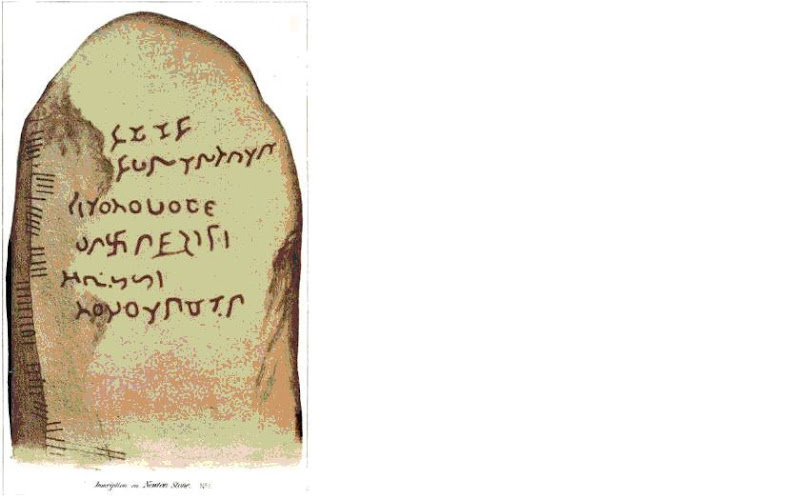
Newton Stone.
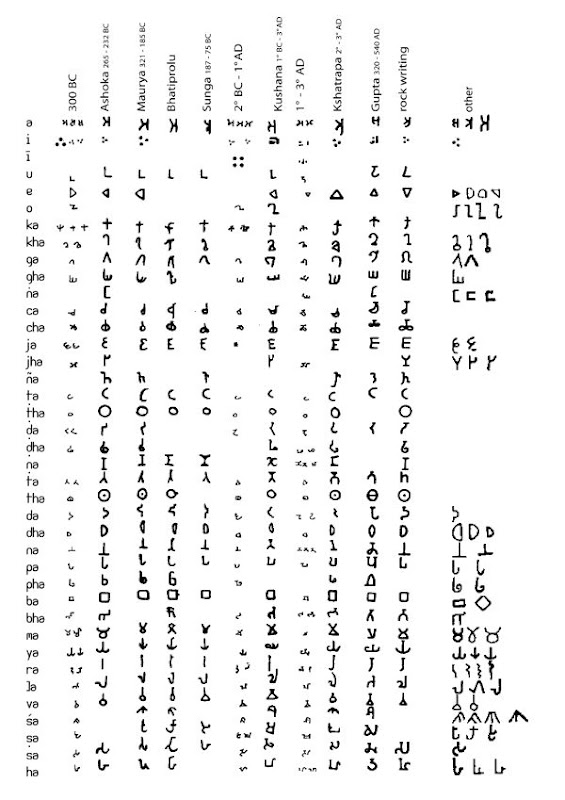
Different variations of Brahmi Scripts
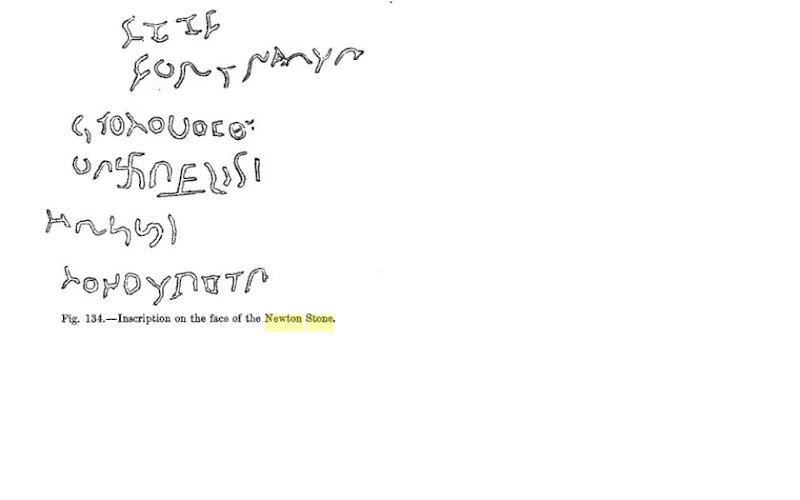 One of Newton Stone Scripts.
One of Newton Stone Scripts.
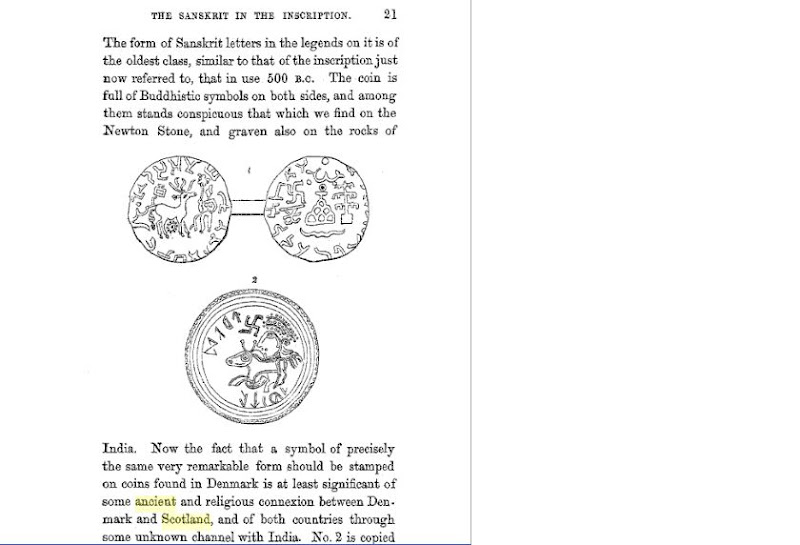
Coins found in Denmark and Nordic Countries with Swastika and Brahami Scripts.
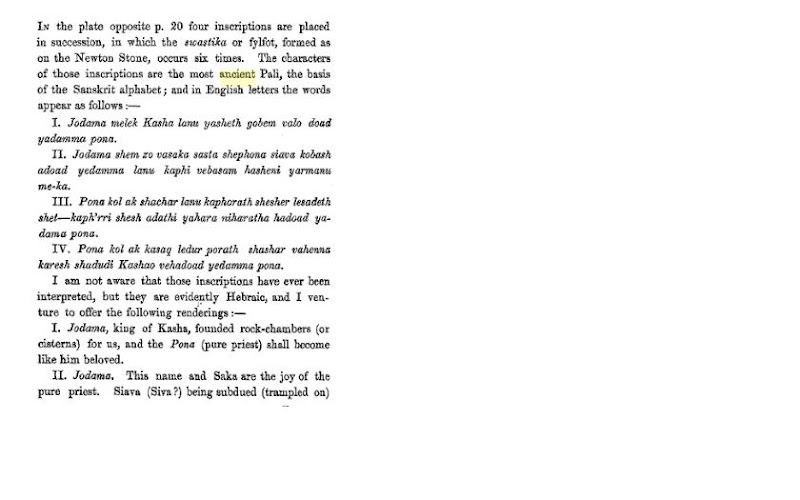 Translation Tranlation of the Script (am not sure how correct it is).
Translation Tranlation of the Script (am not sure how correct it is).

Translation of the Script (am not sure how correct it is).

Translation of the Script (am not sure how correct it is).
The Rev. Dr. Lindsay Alexander stated that he had for long taken an interest in this curious inscription, and had compared it with the Phoenician and other alphabets, but without being able to find anything beyond resemblances. More recently he had been struck with the similarity of character between the letters on the Newton Stone, and those of the Sinaitic Inscriptions, and of the Caves at Ellora. Ref. 1
... traces the existence of the ancient race from India to Europe, but will go on to a reference to the sculptured or inscribed stone, called the " Newton Stone", found in Aberdeenshire, ...
... After giving a long account of the similarity of the letters which are found on the stone to many which are found in ancient caves in India...
There is a great number of pillar stones in Scotland; many are sculptured after a rude fashion, and are almost precisely similar to those existent in India and Ceylon. Elephants are depicted upon some, the legs terminating in scrolls, just in the same fashion as they are depicted in the East. It is singular to see copies of elephants so far from their ordinary habitat; still more curious is it to find that the artist is as conventional in Scotland as in Hindostan... Ref. 2
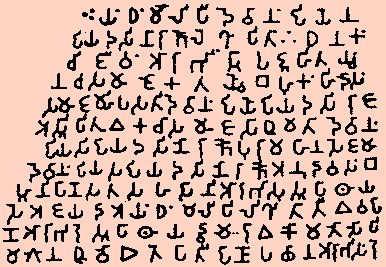
Ashoka's Edict
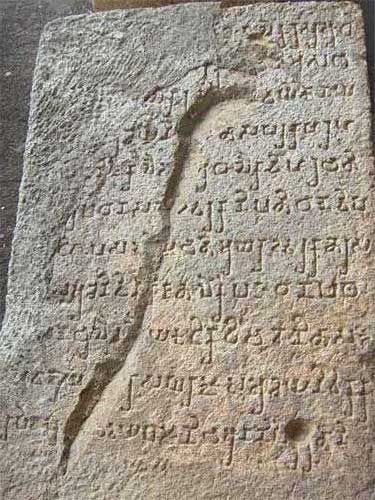
Rock Carving From Kanheri Caves in Jogeshwari Bombay.
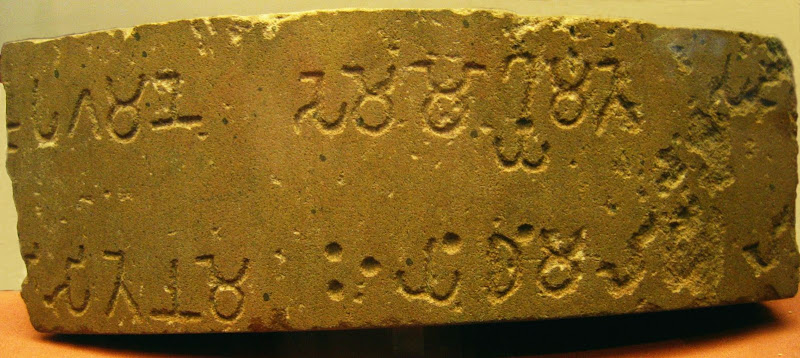
A Fragment from Ashoka's Pillar
What is surprising to me is that why any Indian or any school history student has not heard of this Newton Stone before? So why no one has mentioned this uncanny resemblance of Hindu's and Indian influence all over the globe? It is well documented that the ancient Egyptians and Indians were very akin. Why there river is called Nile, which the Sanskrit word for Blue? It is recorded by Britishers that when they wanted to navigate Nile to its source, only Hindu Brahmins knew about its exact location. (source Anacalypsis). Many of religious beliefs of Egyptians were similar to Hindoos. Like Phallic/Lingam/Obleisk, Snake and Solar worship. Isis and Horus are nothing but corruption of Ishish and Suresh as mentioned in the postings Isis-Jesus-Isha-Isha-masi and On Horus, Chorus, Korus and Suresh.
Why Ramyses's (read Rama-ishish) family married Hittites daughters, who were worshipping Vedic Gods, had Hindu names and Sanskrit like religion. Modern academicians have only lately come to accept this resemblance as put it as as a PIE (Proto Indo European) Civilization, PIE Language, and PIE Religion. Please see following links, Ramesses_II, Hittites, and Indo-Aryan_superstrate_in_Mitanni. Why does Cleopatra sends her son to India when she is defeated along with Mark Anthony by Octavius? See what Pharos have their on their Heads and what Shiva has on its head. See how many Gods they have with animal heads and how many Gods Hindus have with animal heads.
Take the characters from the script and compare with the Brahmi Related Scripts. Any layman would realize that the script is in the same family as of Brahmi and Phoenician. Please see my other postings Common Brahmi And Phoenician Script and Phoenicians And Panis .
What makes it hard is that without knowing which exact language it belongs to, as there are many dialects using the variants of the same script, like it is today with Devanagri, and the fact that the same letters have many variations, and then these letters get modified with "maatras" or vowel measures, which only extends the letters in top and bottom, right and left wise, only making it difficult to read and parse. My children have been reading Hindi and Sanskrit for last 10 years now, but this time I got a different font from the WikiSource and they had a hard time reading the text.
So I have refrained myself in translating the text myself though I was tempted and tried for a short while. I went crazy trying to parse, and also not knowing to read from left to right, bottom to top, or to invert the picture and read it. See my posting Hammu Rabi which has an example of this problem leading to mistakes. But I have included a translation of the transcript and presence of Budhhist characters and Hindo Swastika symbols in coins found in the Nordic and Denmark regions.

Newton Stone.

Different variations of Brahmi Scripts
 One of Newton Stone Scripts.
One of Newton Stone Scripts.
Coins found in Denmark and Nordic Countries with Swastika and Brahami Scripts.
 Translation Tranlation of the Script (am not sure how correct it is).
Translation Tranlation of the Script (am not sure how correct it is).
Translation of the Script (am not sure how correct it is).

Translation of the Script (am not sure how correct it is).
The Rev. Dr. Lindsay Alexander stated that he had for long taken an interest in this curious inscription, and had compared it with the Phoenician and other alphabets, but without being able to find anything beyond resemblances. More recently he had been struck with the similarity of character between the letters on the Newton Stone, and those of the Sinaitic Inscriptions, and of the Caves at Ellora. Ref. 1
... traces the existence of the ancient race from India to Europe, but will go on to a reference to the sculptured or inscribed stone, called the " Newton Stone", found in Aberdeenshire, ...
... After giving a long account of the similarity of the letters which are found on the stone to many which are found in ancient caves in India...
There is a great number of pillar stones in Scotland; many are sculptured after a rude fashion, and are almost precisely similar to those existent in India and Ceylon. Elephants are depicted upon some, the legs terminating in scrolls, just in the same fashion as they are depicted in the East. It is singular to see copies of elephants so far from their ordinary habitat; still more curious is it to find that the artist is as conventional in Scotland as in Hindostan... Ref. 2

Ashoka's Edict

Rock Carving From Kanheri Caves in Jogeshwari Bombay.

A Fragment from Ashoka's Pillar
Stone Circles in Crete - Demeter
Myths of Crete and Pre-Hellenic Europe: Introduction
Demeter of the Grecian Phigalia--the Black Ceres--lived in a cave, which is still regarded as sacred. This deity, who is believed to be a form of the Cretan Great Mother, was also associated with stone circles. Pausanias, writing of the town of Hermione in the Peloponnese, says that near it "there is a circle of huge unhewn stones, and inside this circle they perform the sacred rites of Demeter". 1
Demeter is basically Female or Mother Worship Principle, which in India goes by the name of Durga, Mata, Shakti, Kali, Latha, Bhavani, and so on. In fact people who go to the Vaishno Devi Mandir in India still say "Je Mata De", and please note "Mata De" or "De Mata", which is same as "De Meter". "Matri" is the general noun root, and the singular is "Mata".
This just confirms the same cultural influence from Scotland, Ireland, England and Wales to Crete, Greece, Italy and Antolia.
This backs up the article on Stonehenge also being the principle of Mother/Female and Father/Male Principle, besides other things. It also backs up the find of Aum in the post Aum In Crete And America.
The number 432000 known to Hindus, Persians and Babylonians and encoded in the mythological stories of Italians and Nordic people, is also shown to be encoded in the post on Stonehenge in the series of post covered in the blog. The well known factors of the number 432000 are part of the Stone Circles that are encoded.
Demeter of the Grecian Phigalia--the Black Ceres--lived in a cave, which is still regarded as sacred. This deity, who is believed to be a form of the Cretan Great Mother, was also associated with stone circles. Pausanias, writing of the town of Hermione in the Peloponnese, says that near it "there is a circle of huge unhewn stones, and inside this circle they perform the sacred rites of Demeter". 1
Demeter is basically Female or Mother Worship Principle, which in India goes by the name of Durga, Mata, Shakti, Kali, Latha, Bhavani, and so on. In fact people who go to the Vaishno Devi Mandir in India still say "Je Mata De", and please note "Mata De" or "De Mata", which is same as "De Meter". "Matri" is the general noun root, and the singular is "Mata".
This just confirms the same cultural influence from Scotland, Ireland, England and Wales to Crete, Greece, Italy and Antolia.
This backs up the article on Stonehenge also being the principle of Mother/Female and Father/Male Principle, besides other things. It also backs up the find of Aum in the post Aum In Crete And America.
The number 432000 known to Hindus, Persians and Babylonians and encoded in the mythological stories of Italians and Nordic people, is also shown to be encoded in the post on Stonehenge in the series of post covered in the blog. The well known factors of the number 432000 are part of the Stone Circles that are encoded.
Monday, August 27, 2007
Stone Circles Of The World - Part 3
This is the final part on the Stonehenge, where I would conclude my finding (which I did over 2 weeks of my PTO) that Stonehenge was a giant calendering system, used to track, record and predict days, weeks, months, years, eclipses, solstices and equinoxes, and announce worship and celebrations days on special events.
Stonehenge was many things to many people and most of it has been already talked by others. It was a mausoleum with buried remains or urn containing the cremated ashes of their spiritual or patriarchal leaders. It was also a temple of worship of the Male and Female Principle as Shiv-Lingam and Yoni is to Hindus today. This has been discussed in previous posting and also suggested by others. The previous posting had a drawing which clearly shows the Lingam and Yoni aspect. (In other posting, I would show presence of Shiva in England and Greece). To the learned priest class, it was an observatory and a calender to observe, record and predict solar and lunar events, besides it being a place of worship and celebration. To many people of practical purpose, it was a place of social gathering and a place to do business. We would focus on Stonehenge being a calendering system.
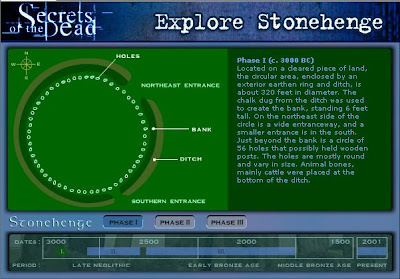
Phase 1 - Showing 56 Holes For Rotating Wooden Posts
56 holes for rotating the wooden posts in above picture shows that the ancients were tracking the 28 day lunar month. It is not clear why they would not cover the whole circle with 28 stones. Perhaps they were tracking the duration between odd full moons or even full moons for better accuracy, like one measures the wave length in a sine wave. Or they were trying to fit 360 solar days in a year with 6.5 turns instead of 13 turns for some reason - or 720 solar days with 13 turns of a 56 stone circle! This was their first attempt to make the calender and may have not been confident in tracking 28 days cycle only.
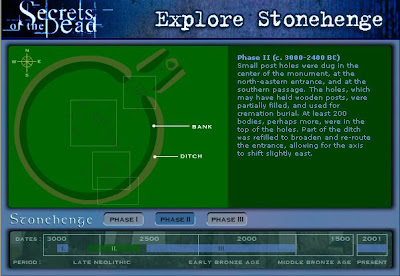
Phase 2 Showing Holes in North East and South East
Phase 2, the holes in center were perhaps to track the years but we would not be sure. And the holes in the north-east side were perhaps to track the Solar Solstices and the holes in the South East perhaps to track Solar Equinoxes. Their is some evidence of the Stonehenge tracking the same event in parallel to avoid mistakes arising because of some natural catastrophe or man made pranks by vandals.
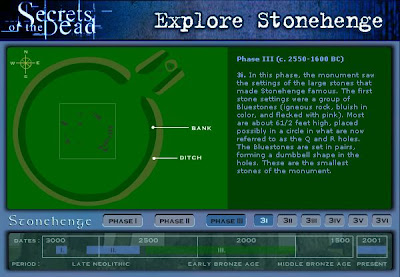
Phase 3 - 1 - Stone Henge
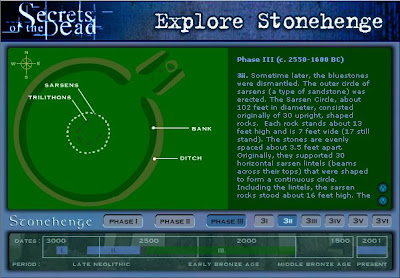
Phase 3-2. Shows 30 Vertical Stones and 30 Horizontal Stones in the Sarsen Circle
Perhaps all this time, the focus was on the size of the stones and how these stones were placed and how they were carried from far off places, that people did not see the connection between different circles.

Phase 3-3 - Stonehenge

Phase 3-4 Stonehenge
20 Stones, and as later we would see, they are placed in 19 + 1 pattern on each side of the semicircle, showing that 20 x 360 = 7200 Solar Days. 600 Years were being tracked, as 31 x 19 + 11 = 600. And 19 was being used to track the Metonic Cycle to predict the Lunar Eclipse. Later it would be shown that a cycle of 31, 30, 28, 24, 11, and 10 could be tracked, like a dial of a watch, besides the cycles of 1, 2, 19, and 20. All they had to do was to place different coded stones and rotate them.
Recall from previous postings that 600 Neros Cycle was being used and later they found that every 72 years the Sun would rise 1 degree off in Summer Solstice, accounting for the wobble of the earth's axis, with the cycle of 25920 years! More on this later.
This knowledge, though shown to be known to all Proto Indo Europeans all over the world in forms of stories in their mythology, was lost by the ancients except for Hindus till date, perhaps showing the most "orthodox" and "staunch" believers of the religion from the ancient times, which is kind of backed by the observation that Hinduism is the last vestige of the Prototype Indo European Religion. Babylonians and Persians knew this, and Egyptians and Greeks had copied this concept, but without keeping up with the Hindus, who kept refining this. Before they settled at 72 years to 1 degree relationship, they would go as far as 100 years and as low as 60 years to 1 degree relationship. I am thinking just a brief on the whole article, as I have realized now that people may not have time to read and patience to digest all the boring details.
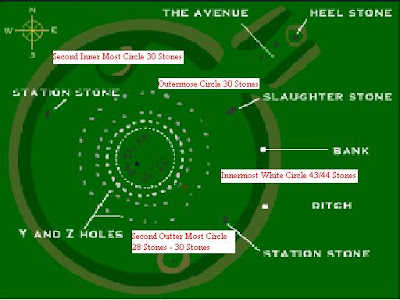
Inner Circle - Stonehenge
The above picture shows that the X and Z holes had 30 stones and 30/28 stones respectively. In another book they have talked about one of the circles having 31 stones. The third inner circle showing 30 stones and the innermost circle having 43 or 44 stones. The multiple 30 stones perhaps indicates tracking solar days in multiple, and/or tracking other larger numbers with factors of 30. If we account for 28 stones in one of the circle, it would be tracking lunar days and month, which makes sense, if one has to account for 2 circles for lunar months (including the outer circle that had 56 stones) and 2 circles for solar months. We are still left with inner most circle of 30 stones and 43/44 stones. Recall we had 20 stones covered in horse show ring, which makes 20 x 30 = 600. It is not clear why we have 43 or 44 stones or if that numbering is correct. There is a wobble of another kind, called "Chandler Wobble", which was discovered recently, and it has a period of 433 days. Since 10 and 5 were encoded in the horse-shoe circle, is it possible to code this as 10 x 43 + 3 ? Interesting, we have shown 4320 was an interesting number to the ancients. So was 43 and 20 being encoded somehow? Also, 19 x 31 + 11 = 600, so 4 x (19 x 31 + 11) = 4 x 19 x 31 + 44 = 2400, which was another cycle of importance, and we shall see that 24 was also encoded in another circle!
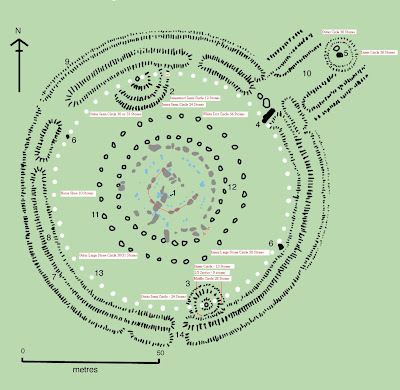
Inner Circle - Stone henge with North-West and South-East Semi/Full Circles (double-click to magnify)
The South East Circles shows 28 stones in Middle Circle , 13 stones in Inner Circle, and 24 stones in Outer circle. 28 x 13 = 364, which is what the later years started looking like, and 24 x 30 = 720. This shows later efforts to reconcile the lunar calender with the solar calender and also account for increase in duration in Solar Years from 360 to 364, 365 and 366 days. Please note, that some "stones" have been counted by extrapolating equidistant points or counting stones in one 1/3 sector. Needless to say, 7200 = 24 x 30 x 10, which was show before as 360 x 20.
The North West Semicircles shows Outer most semicircles with 31/30 and 30 stones, and inner most semicircle with 24 and 12 stones. The use of 24 perhaps backs the observation that the duration between odd or even years was also being tracked for accuracy reasons.
The fact these circles and semi-circles are smaller, showing they were installed later, and somehow being squeezed into a tight space, shows an adapting architecture in Stonehenge as the ancients' knowledge on different astronomical cycles increased and as they shifted from a Lunar Calender to a Solar Calendar.
The NW alley circles, marked 5, has 36 stones each. Knowing that they had stone circles to count factors of 20, 10, 2, it is easy to visualize, they counting cycles 720, 360 and 72! 25920 cycle comes to 36 x 36 x 2 x 10. What this means is that could project cycles of 25920 precession, based on observation of shifting zodiacs associated with the solstices, which they settled down to 1 degree for every 72 years!


The above two pictures, confirm the star was the symbol of Male and Female Principle, which was worshiped by Hindus and Stonehenge alike. The triangle pointing upwards was the Male Principle and the triangle pointing downwards was the Female Principle. Also, most of the stone circles are marked with 2 stones or alleys to mark the passage between the womb, denoted by the circle, and the outer world, to worship the Female Principle.

The picture confirm that that the inner horse-shoe had 19 stones, and the outer horse ring had 10 stones, and the next inner circle had 40 stones, but it pattern of 19 + 1 + 1 + 19. The outer inner circle is confirmed to have 30 stones.
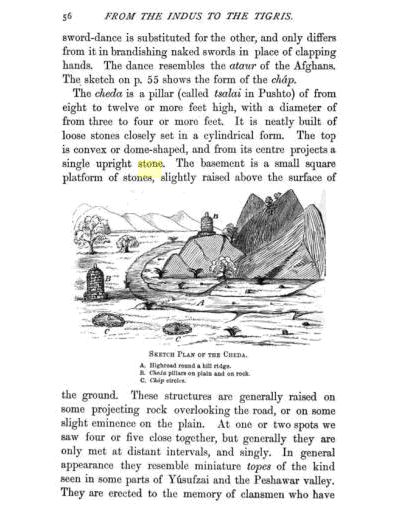
Stonecircles with the Male Principle and the Female Principle Worship found in Afganistan area.
So even, we do not have a complete accurate knowledge of stones in the all circles, in Stonehenge as well in other stone circles from Europe and India, some of the numbers which are needed in the astrology and astronomical observations, do constantly resurface everywhere. And knowing that we inherited these magic numbers from our distant ancients, and did not invent them, it is quite likely that the ancients were lot smarter than we have acknowledged, and their knowledge of mathematics and astronomy was far ahead than it has been acknowledged.
I will conclude the article by borrowing the article from Godfrey Higgins's Anacalypsis, page 313.
THE STONE CIRCLES OF INDIA.
Here I think the temenos was the Gilgal of Dr. Clarke. See CELTIC DRUDS, passim. And from this we may not unreasonably suspect that the re/xei/os meant a stone circle : or, at all events, that a stone circle was a Te/ievos.
In my Celtic Druids I have given an example of two Cromlehs in India, plates 39 and 40, and I have given a drawing of another in figure 18 of this work. I have since found that stone circles, similar to our Stonehenge, Abury, &c., are very common in the northern parts of India. The natives can give no account of them.
These circles appear to be a remnant of antiquity of a similar species to those of the Puniha-Pandawars, a great number of which are to be seen scattered on the adjacent heights about a mile west of a place called Durnacotta. The stones composing these circles are of a hard blackish granite, very irregular in shape, measuring in general about three feet in height, and of the same dimension in thickness. The country people seem ignorant on the subject of these antiquities, and can give no information for what purposes they were designed. It is reported that circles of a similar description are very numerous among the skirts of the hills of Wudlamaun and others in that neighbourhood, that on some of these being opened by the late Rajah, Vassareddy, they were found to contain human bones of a large size, and that in some there were earthen pots curiously placed together containing ashes or charcoal. Similar to the above at Amravutty, on the river Christna or Kistna, is to be seen a mound called Depaldenna.(Note 1)
Drawings of great numbers of these circles may be seen in Mackenzie's manuscripts above-mentioned. I shall give a drawing of only one of them, because, although there is no reason to doubt the general accuracy of the accounts, yet no attempt has been made to ascertain of what numbers of stones these circles originally consisted, which was the only thing that could render them really useful; but which, as was originally the case in England, was thought to be of no consequence. It is, however, remarkable that, in the circle which I have given, fig. u, as the reader will find on counting them (allowance being made for one evidently broken), 19 stones, the number of the Metonic cycle, are found.
Stonehenge was many things to many people and most of it has been already talked by others. It was a mausoleum with buried remains or urn containing the cremated ashes of their spiritual or patriarchal leaders. It was also a temple of worship of the Male and Female Principle as Shiv-Lingam and Yoni is to Hindus today. This has been discussed in previous posting and also suggested by others. The previous posting had a drawing which clearly shows the Lingam and Yoni aspect. (In other posting, I would show presence of Shiva in England and Greece). To the learned priest class, it was an observatory and a calender to observe, record and predict solar and lunar events, besides it being a place of worship and celebration. To many people of practical purpose, it was a place of social gathering and a place to do business. We would focus on Stonehenge being a calendering system.

Phase 1 - Showing 56 Holes For Rotating Wooden Posts
56 holes for rotating the wooden posts in above picture shows that the ancients were tracking the 28 day lunar month. It is not clear why they would not cover the whole circle with 28 stones. Perhaps they were tracking the duration between odd full moons or even full moons for better accuracy, like one measures the wave length in a sine wave. Or they were trying to fit 360 solar days in a year with 6.5 turns instead of 13 turns for some reason - or 720 solar days with 13 turns of a 56 stone circle! This was their first attempt to make the calender and may have not been confident in tracking 28 days cycle only.

Phase 2 Showing Holes in North East and South East
Phase 2, the holes in center were perhaps to track the years but we would not be sure. And the holes in the north-east side were perhaps to track the Solar Solstices and the holes in the South East perhaps to track Solar Equinoxes. Their is some evidence of the Stonehenge tracking the same event in parallel to avoid mistakes arising because of some natural catastrophe or man made pranks by vandals.

Phase 3 - 1 - Stone Henge

Phase 3-2. Shows 30 Vertical Stones and 30 Horizontal Stones in the Sarsen Circle
Perhaps all this time, the focus was on the size of the stones and how these stones were placed and how they were carried from far off places, that people did not see the connection between different circles.

Phase 3-3 - Stonehenge

Phase 3-4 Stonehenge
20 Stones, and as later we would see, they are placed in 19 + 1 pattern on each side of the semicircle, showing that 20 x 360 = 7200 Solar Days. 600 Years were being tracked, as 31 x 19 + 11 = 600. And 19 was being used to track the Metonic Cycle to predict the Lunar Eclipse. Later it would be shown that a cycle of 31, 30, 28, 24, 11, and 10 could be tracked, like a dial of a watch, besides the cycles of 1, 2, 19, and 20. All they had to do was to place different coded stones and rotate them.
Recall from previous postings that 600 Neros Cycle was being used and later they found that every 72 years the Sun would rise 1 degree off in Summer Solstice, accounting for the wobble of the earth's axis, with the cycle of 25920 years! More on this later.
This knowledge, though shown to be known to all Proto Indo Europeans all over the world in forms of stories in their mythology, was lost by the ancients except for Hindus till date, perhaps showing the most "orthodox" and "staunch" believers of the religion from the ancient times, which is kind of backed by the observation that Hinduism is the last vestige of the Prototype Indo European Religion. Babylonians and Persians knew this, and Egyptians and Greeks had copied this concept, but without keeping up with the Hindus, who kept refining this. Before they settled at 72 years to 1 degree relationship, they would go as far as 100 years and as low as 60 years to 1 degree relationship. I am thinking just a brief on the whole article, as I have realized now that people may not have time to read and patience to digest all the boring details.

Inner Circle - Stonehenge
The above picture shows that the X and Z holes had 30 stones and 30/28 stones respectively. In another book they have talked about one of the circles having 31 stones. The third inner circle showing 30 stones and the innermost circle having 43 or 44 stones. The multiple 30 stones perhaps indicates tracking solar days in multiple, and/or tracking other larger numbers with factors of 30. If we account for 28 stones in one of the circle, it would be tracking lunar days and month, which makes sense, if one has to account for 2 circles for lunar months (including the outer circle that had 56 stones) and 2 circles for solar months. We are still left with inner most circle of 30 stones and 43/44 stones. Recall we had 20 stones covered in horse show ring, which makes 20 x 30 = 600. It is not clear why we have 43 or 44 stones or if that numbering is correct. There is a wobble of another kind, called "Chandler Wobble", which was discovered recently, and it has a period of 433 days. Since 10 and 5 were encoded in the horse-shoe circle, is it possible to code this as 10 x 43 + 3 ? Interesting, we have shown 4320 was an interesting number to the ancients. So was 43 and 20 being encoded somehow? Also, 19 x 31 + 11 = 600, so 4 x (19 x 31 + 11) = 4 x 19 x 31 + 44 = 2400, which was another cycle of importance, and we shall see that 24 was also encoded in another circle!

Inner Circle - Stone henge with North-West and South-East Semi/Full Circles (double-click to magnify)
The South East Circles shows 28 stones in Middle Circle , 13 stones in Inner Circle, and 24 stones in Outer circle. 28 x 13 = 364, which is what the later years started looking like, and 24 x 30 = 720. This shows later efforts to reconcile the lunar calender with the solar calender and also account for increase in duration in Solar Years from 360 to 364, 365 and 366 days. Please note, that some "stones" have been counted by extrapolating equidistant points or counting stones in one 1/3 sector. Needless to say, 7200 = 24 x 30 x 10, which was show before as 360 x 20.
The North West Semicircles shows Outer most semicircles with 31/30 and 30 stones, and inner most semicircle with 24 and 12 stones. The use of 24 perhaps backs the observation that the duration between odd or even years was also being tracked for accuracy reasons.
The fact these circles and semi-circles are smaller, showing they were installed later, and somehow being squeezed into a tight space, shows an adapting architecture in Stonehenge as the ancients' knowledge on different astronomical cycles increased and as they shifted from a Lunar Calender to a Solar Calendar.
The NW alley circles, marked 5, has 36 stones each. Knowing that they had stone circles to count factors of 20, 10, 2, it is easy to visualize, they counting cycles 720, 360 and 72! 25920 cycle comes to 36 x 36 x 2 x 10. What this means is that could project cycles of 25920 precession, based on observation of shifting zodiacs associated with the solstices, which they settled down to 1 degree for every 72 years!


The above two pictures, confirm the star was the symbol of Male and Female Principle, which was worshiped by Hindus and Stonehenge alike. The triangle pointing upwards was the Male Principle and the triangle pointing downwards was the Female Principle. Also, most of the stone circles are marked with 2 stones or alleys to mark the passage between the womb, denoted by the circle, and the outer world, to worship the Female Principle.

The picture confirm that that the inner horse-shoe had 19 stones, and the outer horse ring had 10 stones, and the next inner circle had 40 stones, but it pattern of 19 + 1 + 1 + 19. The outer inner circle is confirmed to have 30 stones.

Stonecircles with the Male Principle and the Female Principle Worship found in Afganistan area.
So even, we do not have a complete accurate knowledge of stones in the all circles, in Stonehenge as well in other stone circles from Europe and India, some of the numbers which are needed in the astrology and astronomical observations, do constantly resurface everywhere. And knowing that we inherited these magic numbers from our distant ancients, and did not invent them, it is quite likely that the ancients were lot smarter than we have acknowledged, and their knowledge of mathematics and astronomy was far ahead than it has been acknowledged.
I will conclude the article by borrowing the article from Godfrey Higgins's Anacalypsis, page 313.
THE STONE CIRCLES OF INDIA.
Here I think the temenos was the Gilgal of Dr. Clarke. See CELTIC DRUDS, passim. And from this we may not unreasonably suspect that the re/xei/os meant a stone circle : or, at all events, that a stone circle was a Te/ievos.
In my Celtic Druids I have given an example of two Cromlehs in India, plates 39 and 40, and I have given a drawing of another in figure 18 of this work. I have since found that stone circles, similar to our Stonehenge, Abury, &c., are very common in the northern parts of India. The natives can give no account of them.
These circles appear to be a remnant of antiquity of a similar species to those of the Puniha-Pandawars, a great number of which are to be seen scattered on the adjacent heights about a mile west of a place called Durnacotta. The stones composing these circles are of a hard blackish granite, very irregular in shape, measuring in general about three feet in height, and of the same dimension in thickness. The country people seem ignorant on the subject of these antiquities, and can give no information for what purposes they were designed. It is reported that circles of a similar description are very numerous among the skirts of the hills of Wudlamaun and others in that neighbourhood, that on some of these being opened by the late Rajah, Vassareddy, they were found to contain human bones of a large size, and that in some there were earthen pots curiously placed together containing ashes or charcoal. Similar to the above at Amravutty, on the river Christna or Kistna, is to be seen a mound called Depaldenna.(Note 1)
Drawings of great numbers of these circles may be seen in Mackenzie's manuscripts above-mentioned. I shall give a drawing of only one of them, because, although there is no reason to doubt the general accuracy of the accounts, yet no attempt has been made to ascertain of what numbers of stones these circles originally consisted, which was the only thing that could render them really useful; but which, as was originally the case in England, was thought to be of no consequence. It is, however, remarkable that, in the circle which I have given, fig. u, as the reader will find on counting them (allowance being made for one evidently broken), 19 stones, the number of the Metonic cycle, are found.
Note 1: See Col.Mackenzie's manuscripts, India Antiqua Illustrata, in the musuem in India-House, No 9, 1816-1817, and my plates Fig. 11.
Friday, August 24, 2007
Stone Circles Of The World - Part 2
If the early man has to count and track any passing time events like days, weeks, months and years, he has to first observe the natural events. The obvious natural events are the cycle of sun-rises and sun-sets, marking days and nights, the cycle of changing seasons, repeating season marking an of a year, the cycle of waxing and waning of moon, marking a lunar month, and the cycles of Spring Solstices, Summer Equinoxes, Autumn Equinoxes, and Winter Solstices, each repeating to mark a year completion of preceding like wise event, and associating them with the change of seasons.
It would not take long for him to see the co-relations between some of these events, like between days and months, between lunar months and seasons, between year and seasons, and between seasons and sun rises and sets in spring and autumn equinoxes, and, in summer and winter solstices.
He would be gazing stars and imagine some cluster of stars based on his surrounding animals and give them some zodiac names, e.g. Leo, Taurus, etc. He would align the sun rises and sun sets, and also the moon rises and moon sets, to these imaginary cluster of stars, and see a co-relation repeating over time. So he would expect, to his yet incomplete self tutored mind, the sun rises in all Summer Solstices in the constellation of Taurus in May,and so on. To count these passing events, he would need to mark their passages and track them and project the next events that would follow. This knowledge would be valued to the early men who lived under constant fear of the elements of nature and yet had not mastered it to the extent the modern man has.
What else would be so convenient than to pick the stones and use them as markers for the passing events, by having a "rotating" marker stone be moved around to different "stationary" events stones marking a particular event? He would start with a simple counting and marking mechanism, and as he would spend time doing this exercise, he would soon master the basic math, where a larger number X would be a repetition of some smaller number Y for some number Z times. He would use this knowledge of factorisation to conserve his stone to mark and track multiple time events, and their co relation, without wasting many stones in a complicated machine! The necessity is the mother of invention, and like a modern clock, he would device different circles with different number of stones, representing the same fundamental principle, except that the "motor" was him, the hand were the moving "marker" stones and the numbers were stationery "event" stones! He would show the use of underlying principle of overflow of a "digit", and skipping and not bothering with the left side "digit" till it has overflowed for the first time, as if counting from zero!
Being a man of practical wisdom, he would use the same place for burial and cremation, perhaps of some famous person, like family patriarch and community leader, and also for recording the time events he was observing. And the early man architect would use the same stones in his architecture to erect the temples for worship of his God, as per his understanding! The understanding was the underlying Male and Female principle of regeneration he would see in Sun and Earth respectively. Thus these stone rings became a place of marking nature's events, place of worship, a place of cremation/burial, commemoration of passing of some important personage, and also a social place of meeting and doing transactions! We slowly and surely pace ourselves through these progressions before we finally conclude our grand finally with posting on Stonehenge!

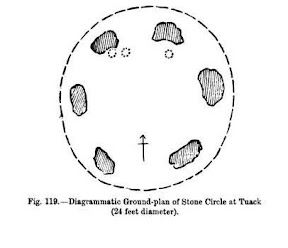
The picture above shows 6 Stones and 1 stone at the center. One could use this to count the 6 seasons which many ancients like Hindoos had, e.g., Vasant (Spring), Grishm (Summer), Varsha (Monsoon), Sharad (Autumn), Hemant (Mild Winter) and Shishu (Intense Winter) Ritus (Seasons). Being a modern man, who is used to computers, satellites, atomic clocks, telescopes, we would find this observation rather silly. But we must place ourselves in the shoes of the primitive man, perhaps going back as far 6000 BC to 3000 BC, which some of the stones in Stonehenge have been dated to.

The picture above shows 7 stones, with 2 missing but with marked places, and 2 to mark the "entrance" and 1 to mark the "alignment", adding them to 12 stones. Please note the number 7 and 12 before we jump to any conclusion. He could cycle the 7 stones for days in a week, perhaps keeping the previous week placed marker stone and adding a new one when passing the same day of the week! And he would have a different color stone for the month, and after 28 days, and 2 days, which he could use the 2 "entrance stones", he would move to the next "month" stone. Like modern engineers, he would revise his techniques after learning from his past mistakes and newer ideas to solve the discovered problems!

The above Stone Ring in Deccan, Southern India, has 28 stones, including the 2 "entrance" stones. Please note this is the number of days in a lunar month, when it is considered that the solar year was 360 days. Please read the Background in Astrology and Religion. All "dotted" stones are easy to identify.
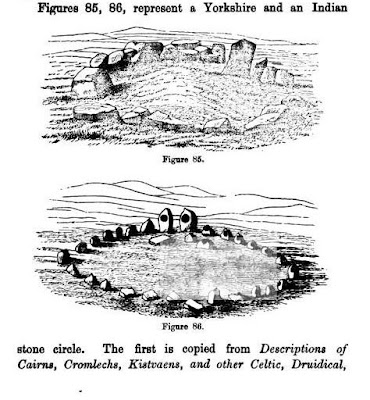
The above "below" Stone Ring in India, has 28 stones, including the 2 "entrance stones". Also, the above "above" Stone Ring in Yorkshire, if some imagination is used to fill up the gaps with missing stones, and count the stones were the "edges" are visible, and not counting the "giant center" stone but imagining 2 stones behind, one can come to 28 stones, or a number close to it.
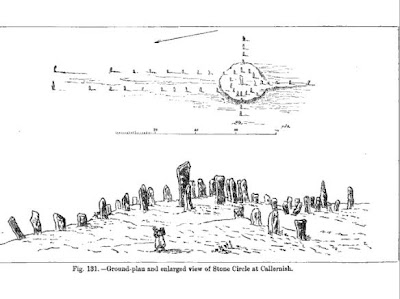
The plan can only be used to count the stones in the inner circle. There is one stone in the center and there are 12 stone making the inner circle. The center stone is the symbol of the Sun or Male Principle and the Circle is the symbol of the Earth or Mother Principle.

The stone circle in Amravati, in India, has around 28, 30 or 31 stones, if one counts all "demarcations" making 1 stone, filling in gaps and following the equidistant rule but allowing the builder a chance to fit big or small stones, but compensating for the increase or decrease in dimension by fitting smaller or bigger stone later on.

Stone ring in "Figure 14", has 21 rings in outer circle and 7 stones in inner circle, adding up to 28 stones, and perhaps the "moving" marker stone moves to the inner circle in the last week of the lunar month! Stone ring in "Figure 13" has approx 28 to 30 stones, if one accounts for smaller stones splitting but trying to keep the imaginary size in mind, yet accounting for some reasonable margin for the builder to adjust the sizes, but on average keeping them same. In "Figure 12" we have 12 Big Stones, and 2 Small Entrance Stones, not counting much smaller and incomparable stones used as filler for the gaps, one can imagine the building either keeping the small stone as a "separating stone" for excluding counting or counting as 13 stone when fitting lunar months into solar years!

In Fig 79, one accounts for last two stones on each side in the rear as making the edges, and counting them as a rectangle of stones made of 8 x 6, we come to 28 stones!
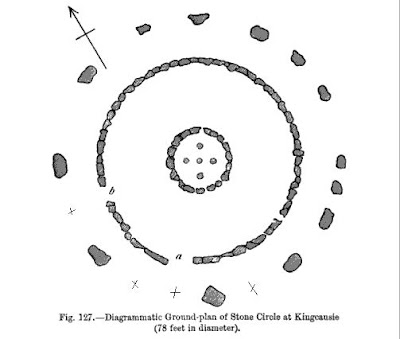
The inner circle has 19 to 20 stones, if one accounts for the 3 small stones with clear marking of edges like big stones. 19 is the Metonic Cycle and 20 is a factor of 60 and 360. If one counts the middle circle, one comes to 60 stones, if we just count the right side semi circle having 30 stones and double it. The outer most stone is difficult to count and strangely, if one just counts the stone marked in unequal distances, with missing gaps, there are 12 of them, which is a strange coincidence! It is difficult to extrapolate the "missing locations" because the gaps are many, but if one tries to put imaginary stones in equidistant, in line with the closest distance already demonstrated with other stones present, one comes to 24 stones! And then there are 4 stones in the center for the cardinal signs and 1 central stone. Strangely, if one moves the "marker" stone around 60 stones in the middle circle, and then moves the second "marker" stone from "imaginary 0" to 1, and then repeats the process for second marker at 2, 3, 4, for "from 1 to 2", "from 2 to 3", "from 3 to 4" and "from 5 to 6" transitions, and at central marked place one comes to 6 cycles of 60 counts, which is 360! The 5 are "overflow" stones for 60 turns of 5 overflows and for without overflow we have a one 60 turn! It is like counting from 0, or before the overflow event happens, we do not write the left most digit, so saving an instance of tracking or writing a "o" digit on left!
This may just look like a surprising coincidence, repeating at many sites, or a consistent oversight of many artists, or my wild imagination in counting them, is any one's guess, but most probably, knowing that the discovery must have been made by our early ancestors, and the evidence of stone circles being aligned with sun rising and sun setting events at solar solstices and equinoxes, it is reasonable to assume that these stone circles were also man's first attempt to clock the days, weeks, months and years and also predict the lunar or solar eclipses!
Now in next posting, we conclude if the same principle repeats in Stonehenge.
It would not take long for him to see the co-relations between some of these events, like between days and months, between lunar months and seasons, between year and seasons, and between seasons and sun rises and sets in spring and autumn equinoxes, and, in summer and winter solstices.
He would be gazing stars and imagine some cluster of stars based on his surrounding animals and give them some zodiac names, e.g. Leo, Taurus, etc. He would align the sun rises and sun sets, and also the moon rises and moon sets, to these imaginary cluster of stars, and see a co-relation repeating over time. So he would expect, to his yet incomplete self tutored mind, the sun rises in all Summer Solstices in the constellation of Taurus in May,and so on. To count these passing events, he would need to mark their passages and track them and project the next events that would follow. This knowledge would be valued to the early men who lived under constant fear of the elements of nature and yet had not mastered it to the extent the modern man has.
What else would be so convenient than to pick the stones and use them as markers for the passing events, by having a "rotating" marker stone be moved around to different "stationary" events stones marking a particular event? He would start with a simple counting and marking mechanism, and as he would spend time doing this exercise, he would soon master the basic math, where a larger number X would be a repetition of some smaller number Y for some number Z times. He would use this knowledge of factorisation to conserve his stone to mark and track multiple time events, and their co relation, without wasting many stones in a complicated machine! The necessity is the mother of invention, and like a modern clock, he would device different circles with different number of stones, representing the same fundamental principle, except that the "motor" was him, the hand were the moving "marker" stones and the numbers were stationery "event" stones! He would show the use of underlying principle of overflow of a "digit", and skipping and not bothering with the left side "digit" till it has overflowed for the first time, as if counting from zero!
Being a man of practical wisdom, he would use the same place for burial and cremation, perhaps of some famous person, like family patriarch and community leader, and also for recording the time events he was observing. And the early man architect would use the same stones in his architecture to erect the temples for worship of his God, as per his understanding! The understanding was the underlying Male and Female principle of regeneration he would see in Sun and Earth respectively. Thus these stone rings became a place of marking nature's events, place of worship, a place of cremation/burial, commemoration of passing of some important personage, and also a social place of meeting and doing transactions! We slowly and surely pace ourselves through these progressions before we finally conclude our grand finally with posting on Stonehenge!


The picture above shows 6 Stones and 1 stone at the center. One could use this to count the 6 seasons which many ancients like Hindoos had, e.g., Vasant (Spring), Grishm (Summer), Varsha (Monsoon), Sharad (Autumn), Hemant (Mild Winter) and Shishu (Intense Winter) Ritus (Seasons). Being a modern man, who is used to computers, satellites, atomic clocks, telescopes, we would find this observation rather silly. But we must place ourselves in the shoes of the primitive man, perhaps going back as far 6000 BC to 3000 BC, which some of the stones in Stonehenge have been dated to.

The picture above shows 7 stones, with 2 missing but with marked places, and 2 to mark the "entrance" and 1 to mark the "alignment", adding them to 12 stones. Please note the number 7 and 12 before we jump to any conclusion. He could cycle the 7 stones for days in a week, perhaps keeping the previous week placed marker stone and adding a new one when passing the same day of the week! And he would have a different color stone for the month, and after 28 days, and 2 days, which he could use the 2 "entrance stones", he would move to the next "month" stone. Like modern engineers, he would revise his techniques after learning from his past mistakes and newer ideas to solve the discovered problems!

The above Stone Ring in Deccan, Southern India, has 28 stones, including the 2 "entrance" stones. Please note this is the number of days in a lunar month, when it is considered that the solar year was 360 days. Please read the Background in Astrology and Religion. All "dotted" stones are easy to identify.

The above "below" Stone Ring in India, has 28 stones, including the 2 "entrance stones". Also, the above "above" Stone Ring in Yorkshire, if some imagination is used to fill up the gaps with missing stones, and count the stones were the "edges" are visible, and not counting the "giant center" stone but imagining 2 stones behind, one can come to 28 stones, or a number close to it.

The plan can only be used to count the stones in the inner circle. There is one stone in the center and there are 12 stone making the inner circle. The center stone is the symbol of the Sun or Male Principle and the Circle is the symbol of the Earth or Mother Principle.

The stone circle in Amravati, in India, has around 28, 30 or 31 stones, if one counts all "demarcations" making 1 stone, filling in gaps and following the equidistant rule but allowing the builder a chance to fit big or small stones, but compensating for the increase or decrease in dimension by fitting smaller or bigger stone later on.

Stone ring in "Figure 14", has 21 rings in outer circle and 7 stones in inner circle, adding up to 28 stones, and perhaps the "moving" marker stone moves to the inner circle in the last week of the lunar month! Stone ring in "Figure 13" has approx 28 to 30 stones, if one accounts for smaller stones splitting but trying to keep the imaginary size in mind, yet accounting for some reasonable margin for the builder to adjust the sizes, but on average keeping them same. In "Figure 12" we have 12 Big Stones, and 2 Small Entrance Stones, not counting much smaller and incomparable stones used as filler for the gaps, one can imagine the building either keeping the small stone as a "separating stone" for excluding counting or counting as 13 stone when fitting lunar months into solar years!

In Fig 79, one accounts for last two stones on each side in the rear as making the edges, and counting them as a rectangle of stones made of 8 x 6, we come to 28 stones!

The inner circle has 19 to 20 stones, if one accounts for the 3 small stones with clear marking of edges like big stones. 19 is the Metonic Cycle and 20 is a factor of 60 and 360. If one counts the middle circle, one comes to 60 stones, if we just count the right side semi circle having 30 stones and double it. The outer most stone is difficult to count and strangely, if one just counts the stone marked in unequal distances, with missing gaps, there are 12 of them, which is a strange coincidence! It is difficult to extrapolate the "missing locations" because the gaps are many, but if one tries to put imaginary stones in equidistant, in line with the closest distance already demonstrated with other stones present, one comes to 24 stones! And then there are 4 stones in the center for the cardinal signs and 1 central stone. Strangely, if one moves the "marker" stone around 60 stones in the middle circle, and then moves the second "marker" stone from "imaginary 0" to 1, and then repeats the process for second marker at 2, 3, 4, for "from 1 to 2", "from 2 to 3", "from 3 to 4" and "from 5 to 6" transitions, and at central marked place one comes to 6 cycles of 60 counts, which is 360! The 5 are "overflow" stones for 60 turns of 5 overflows and for without overflow we have a one 60 turn! It is like counting from 0, or before the overflow event happens, we do not write the left most digit, so saving an instance of tracking or writing a "o" digit on left!
This may just look like a surprising coincidence, repeating at many sites, or a consistent oversight of many artists, or my wild imagination in counting them, is any one's guess, but most probably, knowing that the discovery must have been made by our early ancestors, and the evidence of stone circles being aligned with sun rising and sun setting events at solar solstices and equinoxes, it is reasonable to assume that these stone circles were also man's first attempt to clock the days, weeks, months and years and also predict the lunar or solar eclipses!
Now in next posting, we conclude if the same principle repeats in Stonehenge.
Hindus and Celts Commonality
Adapted from The Early Races of Scotland and Their Monuments By Forbes Leslie, page 451 onwards.
SIMILAR PRIMITIVE MONUMENTS FOUND IN THE INDIAN PENINSULA, IN WESTERN EUROPE, AND IN INTERMEDIATE COUNTRIES OF ASIA AND AFRICA.
Common Element in Languages of Countries extending from the Himalayas to the Hebrides, and a remarkable similarity in Primitive Monuments over the same Extent—Primitive Monuments of India existed prior to the Rock-cut Temples—Circular Stone Fanes still commonly erected in India—Sacrifice of Goats and Cocks—The Number of Stones in the Circle had reference to the Numbers of those who were to partake of the Sacrifice— Stones similarly placed at Superstitions Ceremonies in Scotland— Bali and Baal—List of Monuments common to India and the Celtic Countries of Western Europe—Similar Monuments in Persia and Media; in Syria, Palestine, Phoenicia, Circassia, Troy, Malta, Goza, Tunis, Algeria and the North Coast of Africa, Italy, Spain, Lusitania, Gaul, Armoriea, the Channel Islands, Great Britain, and Ireland.
IT is only in very recent times that philologists have fully compared and finally traced striking relations and common elements in the language of nations extending from the remote Hebrides to the Himalaya mountains, and have proved the intimate connection of the Celtic with the Sanscrit. (Note 1) Evidence confirmatory of the latter fact could, if it were necessary, be developed to a much greater extent; if not (continued)
Note 1 particularly refer to the facts Notes, etc., of Professor Wilson; to made known by Bopp's Comparative Pritchard's Celtic Nations, by Latham ; Grammar, translated and edited by and to Latham Y. Descriptive Ethno- Professor Eastwick, and with theology.
PRIMITIVE CYCLOPEAN REMAINS.
in the structure of the languages, certainly in the identity of words that are expressive of the same meaning in Sanscrit and Celtic dialects. From the comparative rudeness of the Celtic it may be inferred that, if derived from a common origin with the Sanscrit, it must have separated from the parent stock at a very remote period, long prior to the age of the earliest Vedic hymns—viz. the Rigveda—vibich, there is reason to believe, cannot have existed less, but portions of which were promulgated more than three thousand years ago.
The object of the present and immediately succeeding chapters is to show that many of the primitive monuments, customs, superstitions, rites, sacrifices, and objects of worship of the races inhabiting the peninsula of India were similar to those of the Celtic tribes in France and Britain. In a less degree, perhaps because not so well known, analogous monuments and customs will be noticed as existing in intermediate countries.
The departure of the Celtic race from the land of their ancestors and the East, if they did so depart, and from where- ever it may have been that they proceeded, must have occurred at a very early and pre-historic period, when arts and civilisation were but faintly developed, and architecture was not only unknown in the region of their exodus, but also in the nations and countries through which they passed or on which they intruded ; for notwithstanding the cold and moist climate of North Britain and the exposed peninsulas of Armorica, the dwellings of the Celts were not formed of durable materials. Yet in the Cyclopean monuments of these countries (continued)
CELTIC MIGRATION.
see proofs that the Celtic people could transport and raise masses of stone which in size were only surpassed by those in the ancient monuments of Egypt.
The disconnected links of a chain of Cyclopean monuments nearly similar in structure may be traced from Central and Western Asia, perhaps even from more remote countries, along the shores of the Mediterranean Sea, particularly on the north coast of Africa ; from thence by Spain and Gaul to the extremities of the British Isles.
The notices of such monuments were collected before I became aware of Dr. Meyer's opinion regarding the routes by which the Celtic nations passed into Europe ; and the existence of these remains in the line mentioned certainly appears to be in some degree corroborative of his views,1 in so far as regards the principal and earliest migration and route pursued by the Celts in their progress to the extreme west of the then known world.
Dr. Meyer thinks that the Celtic nation passed from Asia to Europe by two principal routes, which it resumed at different epochs, and thus formed two great streams of migration, flowing as it were periodically.2 The one, in a south-western direction, proceeding through Syria and Egypt, thence along the northern coast of Africa, reached Europe at the Pillars of Hercules, and passing on through Spain to Gaul, then divided (continued)
Note 1. Other circumstances favouring the euce to the earliest recorded legend of opinion of Dr. lleyer are mentioned the monument at Stonehenge. in treating of the Lia-Fail, or " Stone
Note 2. Dr. Charles Meyer, in the Report of Destiny," now in the coronation- of the British Association for the Ad- i hair at Westminster ; and in refer- oancement of Science, 1847, p. 303.
PRIMITIVE CYCLOPEAN HEMAINS.
itself into three branches—the northern of which terminated in Grunt Britain and Ireland, the southern in Italy, and the eastern, running along the Alps and the Danube, terminated near the Black Sea. The other great stream of Celtic migration, proceeding in a more direct line, reached Europe at its eastern limit, and passing through European Scythia, and thence partly through Scandinavia, partly along the Baltic, through Prussia, and through Northern Germany, reached Britain across the German Ocean. Of these two streams of migration, the former (viz. by the north coast of Africa), although the less direct, seems to be the more ancient, and to have reached the north-west of Europe several centuries before the other.
The following are a few details regarding the Cyclopean monuments of India, which are similar to those of the Celtic countries of Western Europe ; including notices of monuments of like construction in intermediate countries, particularly such as are in the line of migration indicated by Dr. Meyer as that by which the earliest Celtic emigrants reached Gaul and Britain.
The identity or very strong resemblance of ancient monuments, superstitions, and customs existing in countries geographically remote and historically unconnected, cannot be solely attributed to certain animal instincts implanted in mankind. In cases where the resemblance is undoubted and the peculiarities great, such coincidences may with more probability be referred to former communication between the nations in which they appear, although intercourse between (continued)
SIMILAR PRIMITIVE MONUMENTS.
them, may be unknown to or unnoticed by history. By some writers the similar effects on isolated human communities by natural impulses said to be developed in certain phases of civilisation in the most distant countries and different climates have surely been overrated, and such coincidences may with probability be limited to exertions of intellect that but little surpass the instinct displayed not only by the higher order of unreasoning animals but even by members of the insect creation.
Architectural uniformity, although instinctive in the lower members of the animated creation, is certainly not an attribute of mankind. In the simple huts formed of stakes and rushes or of pickets and palm-leaves, in the underground houses the formation of which is attributed to pigmies, and in excavated cathedrals and Cyclopean structures, of which genii and giants get credit both for the design and execution, no two edifices are alike. This diversity of form in temples, dwellings, and monuments is common to all races and to all ages ; for as in ancient so also in modern times, and in the most civilised communities, as great a variety is observable in the fashion of the dwellings as in the features of their occupants. From the frail huts constructed by gipsies on a common to the palaces built for kings in the city, all are dissimilar, unless in some few situations where arbitrary power has enforced, in external appearance, an unnatural uniformity •which is dull and displeasing to the eye even in street architecture.
Columnar megalithic fanes, dolmens, kistvaens, and several (continued)
PRIMITIVE CYCLOPEAN REMAINS.
varieties of Cyclopean monuments found in Celtic and other countries have their peculiarities, and are not simple suggestions such as might be supposed to arise in the untutored minds of alien races. The square or the triangle are as likely as the circle or ellipse to present themselves as satisfactory forms in which to arrange the columnar masses meant to designate a sacred enclosure; and the dolmens are neither peculiarly simple in design nor easy of execution when we consider the great masses of rock of which they are frequently composed.
It will not be disputed that the primitive Cyclopean monuments of the Dekhan of India were erected prior to the arrival of the present dominant race—the Hindus—who intruded themselves and introduced the Sanscrit language. The onward progress of the Hindus to general dominion in the Indian peninsula has, however, been so gradual and insidious that it is impossible to fix with any approach to accuracy when these intruders overcame the former possessors of the elevated table-land in which these monuments are most abundant. It may even be doubted, and on good grounds has been disputed, whether the immediate predecessors of the Hindus—the race that speak the most cultivated languages of Southern India, as the Telinga, Tamul, Cauaresse, etc. —were the architects of the Cyclopean fanes and the occupants of the sepulchral tumuli of the Dekhan. They certainly do not appear to have been the aborigines, but to have supplanted an earlier people, as they were themselves overcome by the later migration of the Hindus from beyond the Yindhyan range of hills.
SIMILAR PRIMITIVE MONUMENTS FOUND IN THE INDIAN PENINSULA, IN WESTERN EUROPE, AND IN INTERMEDIATE COUNTRIES OF ASIA AND AFRICA.
Common Element in Languages of Countries extending from the Himalayas to the Hebrides, and a remarkable similarity in Primitive Monuments over the same Extent—Primitive Monuments of India existed prior to the Rock-cut Temples—Circular Stone Fanes still commonly erected in India—Sacrifice of Goats and Cocks—The Number of Stones in the Circle had reference to the Numbers of those who were to partake of the Sacrifice— Stones similarly placed at Superstitions Ceremonies in Scotland— Bali and Baal—List of Monuments common to India and the Celtic Countries of Western Europe—Similar Monuments in Persia and Media; in Syria, Palestine, Phoenicia, Circassia, Troy, Malta, Goza, Tunis, Algeria and the North Coast of Africa, Italy, Spain, Lusitania, Gaul, Armoriea, the Channel Islands, Great Britain, and Ireland.
IT is only in very recent times that philologists have fully compared and finally traced striking relations and common elements in the language of nations extending from the remote Hebrides to the Himalaya mountains, and have proved the intimate connection of the Celtic with the Sanscrit. (Note 1) Evidence confirmatory of the latter fact could, if it were necessary, be developed to a much greater extent; if not (continued)
Note 1 particularly refer to the facts Notes, etc., of Professor Wilson; to made known by Bopp's Comparative Pritchard's Celtic Nations, by Latham ; Grammar, translated and edited by and to Latham Y. Descriptive Ethno- Professor Eastwick, and with theology.
PRIMITIVE CYCLOPEAN REMAINS.
in the structure of the languages, certainly in the identity of words that are expressive of the same meaning in Sanscrit and Celtic dialects. From the comparative rudeness of the Celtic it may be inferred that, if derived from a common origin with the Sanscrit, it must have separated from the parent stock at a very remote period, long prior to the age of the earliest Vedic hymns—viz. the Rigveda—vibich, there is reason to believe, cannot have existed less, but portions of which were promulgated more than three thousand years ago.
The object of the present and immediately succeeding chapters is to show that many of the primitive monuments, customs, superstitions, rites, sacrifices, and objects of worship of the races inhabiting the peninsula of India were similar to those of the Celtic tribes in France and Britain. In a less degree, perhaps because not so well known, analogous monuments and customs will be noticed as existing in intermediate countries.
The departure of the Celtic race from the land of their ancestors and the East, if they did so depart, and from where- ever it may have been that they proceeded, must have occurred at a very early and pre-historic period, when arts and civilisation were but faintly developed, and architecture was not only unknown in the region of their exodus, but also in the nations and countries through which they passed or on which they intruded ; for notwithstanding the cold and moist climate of North Britain and the exposed peninsulas of Armorica, the dwellings of the Celts were not formed of durable materials. Yet in the Cyclopean monuments of these countries (continued)
CELTIC MIGRATION.
see proofs that the Celtic people could transport and raise masses of stone which in size were only surpassed by those in the ancient monuments of Egypt.
The disconnected links of a chain of Cyclopean monuments nearly similar in structure may be traced from Central and Western Asia, perhaps even from more remote countries, along the shores of the Mediterranean Sea, particularly on the north coast of Africa ; from thence by Spain and Gaul to the extremities of the British Isles.
The notices of such monuments were collected before I became aware of Dr. Meyer's opinion regarding the routes by which the Celtic nations passed into Europe ; and the existence of these remains in the line mentioned certainly appears to be in some degree corroborative of his views,1 in so far as regards the principal and earliest migration and route pursued by the Celts in their progress to the extreme west of the then known world.
Dr. Meyer thinks that the Celtic nation passed from Asia to Europe by two principal routes, which it resumed at different epochs, and thus formed two great streams of migration, flowing as it were periodically.2 The one, in a south-western direction, proceeding through Syria and Egypt, thence along the northern coast of Africa, reached Europe at the Pillars of Hercules, and passing on through Spain to Gaul, then divided (continued)
Note 1. Other circumstances favouring the euce to the earliest recorded legend of opinion of Dr. lleyer are mentioned the monument at Stonehenge. in treating of the Lia-Fail, or " Stone
Note 2. Dr. Charles Meyer, in the Report of Destiny," now in the coronation- of the British Association for the Ad- i hair at Westminster ; and in refer- oancement of Science, 1847, p. 303.
PRIMITIVE CYCLOPEAN HEMAINS.
itself into three branches—the northern of which terminated in Grunt Britain and Ireland, the southern in Italy, and the eastern, running along the Alps and the Danube, terminated near the Black Sea. The other great stream of Celtic migration, proceeding in a more direct line, reached Europe at its eastern limit, and passing through European Scythia, and thence partly through Scandinavia, partly along the Baltic, through Prussia, and through Northern Germany, reached Britain across the German Ocean. Of these two streams of migration, the former (viz. by the north coast of Africa), although the less direct, seems to be the more ancient, and to have reached the north-west of Europe several centuries before the other.
The following are a few details regarding the Cyclopean monuments of India, which are similar to those of the Celtic countries of Western Europe ; including notices of monuments of like construction in intermediate countries, particularly such as are in the line of migration indicated by Dr. Meyer as that by which the earliest Celtic emigrants reached Gaul and Britain.
The identity or very strong resemblance of ancient monuments, superstitions, and customs existing in countries geographically remote and historically unconnected, cannot be solely attributed to certain animal instincts implanted in mankind. In cases where the resemblance is undoubted and the peculiarities great, such coincidences may with more probability be referred to former communication between the nations in which they appear, although intercourse between (continued)
SIMILAR PRIMITIVE MONUMENTS.
them, may be unknown to or unnoticed by history. By some writers the similar effects on isolated human communities by natural impulses said to be developed in certain phases of civilisation in the most distant countries and different climates have surely been overrated, and such coincidences may with probability be limited to exertions of intellect that but little surpass the instinct displayed not only by the higher order of unreasoning animals but even by members of the insect creation.
Architectural uniformity, although instinctive in the lower members of the animated creation, is certainly not an attribute of mankind. In the simple huts formed of stakes and rushes or of pickets and palm-leaves, in the underground houses the formation of which is attributed to pigmies, and in excavated cathedrals and Cyclopean structures, of which genii and giants get credit both for the design and execution, no two edifices are alike. This diversity of form in temples, dwellings, and monuments is common to all races and to all ages ; for as in ancient so also in modern times, and in the most civilised communities, as great a variety is observable in the fashion of the dwellings as in the features of their occupants. From the frail huts constructed by gipsies on a common to the palaces built for kings in the city, all are dissimilar, unless in some few situations where arbitrary power has enforced, in external appearance, an unnatural uniformity •which is dull and displeasing to the eye even in street architecture.
Columnar megalithic fanes, dolmens, kistvaens, and several (continued)
PRIMITIVE CYCLOPEAN REMAINS.
varieties of Cyclopean monuments found in Celtic and other countries have their peculiarities, and are not simple suggestions such as might be supposed to arise in the untutored minds of alien races. The square or the triangle are as likely as the circle or ellipse to present themselves as satisfactory forms in which to arrange the columnar masses meant to designate a sacred enclosure; and the dolmens are neither peculiarly simple in design nor easy of execution when we consider the great masses of rock of which they are frequently composed.
It will not be disputed that the primitive Cyclopean monuments of the Dekhan of India were erected prior to the arrival of the present dominant race—the Hindus—who intruded themselves and introduced the Sanscrit language. The onward progress of the Hindus to general dominion in the Indian peninsula has, however, been so gradual and insidious that it is impossible to fix with any approach to accuracy when these intruders overcame the former possessors of the elevated table-land in which these monuments are most abundant. It may even be doubted, and on good grounds has been disputed, whether the immediate predecessors of the Hindus—the race that speak the most cultivated languages of Southern India, as the Telinga, Tamul, Cauaresse, etc. —were the architects of the Cyclopean fanes and the occupants of the sepulchral tumuli of the Dekhan. They certainly do not appear to have been the aborigines, but to have supplanted an earlier people, as they were themselves overcome by the later migration of the Hindus from beyond the Yindhyan range of hills.
Wednesday, August 22, 2007
Stone Circles of The World - Part 1
We have talked about the Male and Female Principle Worship in all nations and civilizations, of which for now it is sufficient to accept and proceed. In one of the postings, we shall dwell deeper into the subjects of Male and Female Principle. The Male Principle was symbolized by "phallic" (please see my Sanskrit-ized words link for the explanation), "lingam", "obelisk", "pillar", "scepter" or "mace". The Female Principle was symbolized by "Yoni", circle or oval enclosure, often with a passage for connecting the outside with inside. For Jews this became the Star of David, which has two triangles, one pointing upwards, which symbolizes the Male Principle, the other pointing downwards, which symbolizes the Female Principle.
The ancients worshiped "Male" and "Female" Power of Regeneration aspects that they perceived in Nature and the Divinity, which the Nature is part of it. Like fashion, language, culture, values, science, and art changes with time, religious and ideas on God change, and I will bet you that in future the idea of God will change and the symbols used to represent Him. Please read my other postings.
If you look at the symbol of Lingam and Yoni, from the top, it looks like an Electric Terminal of a Circuit Depicted in an Electrical Circuit Diagram, which conveys the same principle, of Positive and Negative Energy Forces. Here the Shiv Lingam is the symbol of Male Principle and Yoni is the Female Principle.
They ancients would treat Sun as the Male or Father Principle of Divinity. And the Earth as Female or Mother Principle of Divinity. When the Sun would go away to the Tropic of Capricorn, the ancestors being Farmers and heavily depended on the mercy of the powers of Nature and specially Sun (read they were very scientific in this understanding), they would envisage that their God, was so merciful that it would come back like a Father in Spring Equinox and Summer Solstice, and shower rains (make love to mother earth) and Earth with it's Female Principle would bring forth its produce and life here on earth would revive. They needed symbols and they were not vulgar like the today's modern mind and man is (see even today the tribal women are still not shy of revealing their breasts) and were very simple and had no guilt or complex as taught by the Judea Christian Theology on this issue. So the ancients developed the symbol denoting the Male and Female Principles. So this aspect was prevalent all over the world, specially in the Middle East, Europe, India, Greece, Crete, Egypt, Italy, and even Americas. Also people would like to have an Eternal Life and Snake was the symbol of that (because it would shed its skin every year - thus rejuvenate itself). As usual, the symbols sometimes get mixed and true meanings get lost.
So with this background, lets proceed with what other scholars have said.
Myths of Crete and Pre-Hellenic Europe: Introduction
Demeter of the Grecian Phigalia--the Black Ceres--lived in a cave, which is still regarded as sacred. This deity, who is believed to be a form of the Cretan Great Mother, was also associated with stone circles. Pausanias, writing of the town of Hermione in the Peloponnese, says that near it "there is a circle of huge unhewn stones, and inside this circle they perform the sacred rites of Demeter".
Wonderful Ethiopians of the Ancient Cushite Empire
Alexander the Great said that Arabia was inferior to no country of the earth. He referred to the once famous town of Oman, which had been a harbor of the ancient commerce. It was in the day of Alexander a wilderness. His estimate of these Cushites was, "Taking them all in all, they are the richest nation of the world." Alexander lived in the declining days of Ethiopian power. Himyar was the son of Seba, the son of Cush. These were the people of Yemen and the Sabaeans of the Greeks. Lenormant called them related to the Accadians of Shinar and the Ghez of Abyssinia. Himyar became the head of the dynasty of Himyarites. These Cushite Arabians were a fine race of remarkable stature, and dark complexion. The Semitic Arabians are brown, thin, small, well formed and of opposite traits from the Cushite Arabian. The Omanee kingdom attained a latter great splendor at the beginning of the Nineteenth Century. The conquering Mohammedan tribes of the north in idol-destroying mood have effaced all the pagan temples that once covered Arabia. Several enormous stone circles like those of some parts of Europe, built as a form of primitive religion, still remain.
The Secret Doctrine by H. P. Blavatsky, vol 2, part 1, Cyclopean
"Bones are found in them (the tombs)," he says, "and Mr. Hillwell tells us that some of these are enormous, the natives (of Malabar) calling the tombs the dwellings of Rakshasas (giants)." Several stone circles, "considered the work of the Panch Pandava (five Pandus), as all such monuments are in India, so numerous in that country," when opened by the direction of Rajah Vasariddi, "were found to contain human bones of a very large size." (T. A. Wise, in "History of Paganism in Caledonia," p. 36).
In both America and Egypt the pyramids were used as places of sepulture; and it is a remarkable fact that the system of earthworks and mounds, kindred to the pyramids, is found even in England. Silsbury Hill, at Avebury, is an artificial mound one hundred and seventy feet high. It is connected with ramparts, avenues (fourteen hundred and eighty yards long), circular ditches, and stone circles, almost identical with those found in the valley of the Mississippi. In Ireland the dead were buried in vaults of stone, and the earth raised over them in pyramids flattened on the top. They were called "moats" by the people. We have found the stone vaults at the base of similar truncated pyramids in Ohio. There can be no doubt that the pyramid was a developed and perfected mound, and that the parent form of these curious structures is to be found in Silsbury Hill, and in the mounds of earth of Central America and the Mississippi Valley.
We find the emblem of the Cross in pre-Christian times venerated as a holy symbol on both sides of the Atlantic; and we find it explained as a type of the four rivers of the happy island where the civilization of the race originated.
Worship of the Serpent: Chapter III. Serpent-Worship in Europe
The learned Celtic scholar, from whose translation the above poem is taken, explains it in these words:--"These ceremonies are performed at a public and solemn festival, whilst the sanctuary, or assembly of priests and votaries, invoke the dragon king. The place of consecration is on the sacred mound, within the stone circle and mount which represent the world, and near the consecrated lakes 1. At this time the huge stones of the temple were covered with a veil, on which was delineated the history of the dragon king. There seems also to have been a living serpent as a symbol of the god, who is gliding from place to place, and tasting the drink-offerings in the sacred vessels 1."
Joseph Anderson, in his book Scotland in Pagan Times, in chapter on Bronze Age Burial, mentions of Urns found in the stone ring sites in Europe, sometimes with signs of burial and sometimes with signs of cremation, just like the Hindus keep their "asthis" or "rakh" of their deceased dead ones in an urn till an opportune time comes to dispose them off in a favourable manner. Usually it is immersing them in some sacred river, but sometimes it is buried in a memorial site meant for the deceased person. Similarly, for famous saints and spiritual leaders, their bodies is not cremated but buried. Sometimes children would also not be cremeted. (My Note 1).
My Note 1. The word Pagan comes from Latin which was used to denote the rural people who stuck to their ancestral religions in the times of christian conversions and it was used to deride their religion, as it today, by the Christian Zealots. Knowing the linguistic connections, the root word is "pak" comes close, and it means pure, orthodox, cooked, solid, inflexible. If root is taken as "paGk", it means related to "mud" or "slush", which is related to rustic or rural context.
(My Note 2).
Page 9 From this I infer that when the blade was placed among the burnt bones of its owner, it had not, like them, passed through the fire, but laid been deposited ...
Page 21 The burnt bones had been collected, and placed in a shallow excavation in the sandy eminence, with a large flowerpot-shaped urn of baked clay ...
Page 23 The burials were of burnt bodies, the incinerated bones deposited in urns. The blade was found with the burial marked ...
Page 26 They are vaguely stated to have been found " in two urns, mixed with burnt bones." One of these four articles is a bronze socketed axe-head ...
Page 43 It was found at one side of a deposit of burnt bones from 3 to 4 inches in thickness, placed about 2 feet under the surface, and covering an area of about ...
Page 45 ... mass of ashes and burnt bones of very small size, which were determined from the presence of a milk molar to be those of an infant. ...
Page 49 In the bottom was a layer of burnt bones 2 inches thick, among which was ...
Page 57 There was no urn observed, but the deposit was not carefully examined, and the only things that seem to have attracted attention were the burnt bones which ...
Page 63 It lay close to two of the burnt burials that were first discovered, and on the flat stone cover of the cist which contained the skeleton were two ...
Page 67 In the cist was a deposit of burnt bones, and at one corner on a piece of flat stone lay four discs of thin gold, and a necklace of beads of amber. ...
Page 69 We find this characteristic feature associated alike with burnt and with unburnt interments ; with burials in cairns, and with burials in natural mounds, ...
Page 70 two are found associated with burnt burials, and two with burials unburnt :— First Group.—Cinerary urns, containing or covering the ...
Page 90 We have frequently found the burnt interments and the interments unburnt in close juxtaposition in the same group of burials, and in point of fact the two ...
Page 91 filled with burnt bones. One was inverted over the bones, the position of the other was not ascertained. Both were simply set in the ...
Page 92 It is probable that this case at Tealing was a similar one, and that the two overlying burnt bodies were laid there at the same time as the unburnt body. ...
Page 104 The interments are burnt, and associated with cinerary urns of the same typical form and ornamentation, and with the same characteristic thin flat blade of ...
Page 116 128), which was found filled with burnt bones, was subsequently sent to the National Museum. It is of the cinerary form, and more than usually ornate in ...
Page 117 From the fact that they contain interments, burnt and unburnt, it is obvious that they were in when both these customs were practised, while the occurrence ...
Page 132 One of the cairns, which contained a central cist, 4 feet long, in which was a burnt interment and some beads of jet, had a circle of stones set at ...
Page 171 An arrow-head of flint was found with a burnt interment in a barrow at Wilsford, also in South Wilts, with which there was a bronze dagger and a whetstone. ...
Page 240 Beads of Lignite compacted clay and ashes, fully 6 inches in thickness, intermixed with charcoal, and burnt bones, human and animal. ...
Page 252 This layer of burnt bones and ashes, which formed the floor of the chamber, was from 9 inches to a foot in thickness. Imbedded in it were a considerable ...
Page 253 On the floors Mr. Rhind found bones, unburnt, and in the floors burnt bones and pottery, but he met with no flint chips or implements of any kind ; and his ...
Page 260 The whole floor of the principal chamber and the inner part of the entrance passage consisted of an accumulation of ashes and broken and burnt bones, ...
Page 263 No relics of any kind were discovered in the examination of these chambers, but the floors still afford indications of the presence of charcoal and burnt ...
Page 314 It is supposed to have been washed out of a cairn of stones in which an un- burnt burial was subsequently found ...
Often, the burial sites were associated with Stone Rings, where worship and religious activities were associated. It is not common to have the burial places of saints and spiritual leaders become places of worship in all parts of the world, including India, and among Hindus, specially the Swamis who have taken samadhi. Stone Rings are often found associated with Standing Stones, and if often the symbol of union of Male and Female Principle. This is my conjecture that the ancients believed in life after death, and in re-incarnation, and would epitomize the stone ring as "mother's womb", and for protection after life, a burial in a chamber would often be present. For those taking the reincarnation literally, or choosing to preserve the remains of their divine saints, would choose burial. Those believing in the subtle sense of reincarnation and understand the deeper meaning of "from ashes to ashes", would choose cremation. (My Note 2).
My Note 2.
Page 97 ... externally by overground erections or stone-settings, such as are known in this country by the names of Stone Circles, or groups of Standing Stones. ...
Page 101 They differ from those previously described in one respect only,—they are marked above ground by the presence of a stone-setting of peculiar character, ...
Page 103 CIRCLES, AND SETTINGS OF STANDING STONES. equally characteristic. Close by the stone which stood to the west of the north point in the circumference of the ...more »
Page 105 122). 11 s base was formed of flat slabs, the inner edges of which .¡1 and 122.—Ground-plan and Section of Stone Circle at Crichie, ...
Page 107 CIRCLES, AND SETTINGS OF STANDING STONES. its outlines, but deeply hollowed on the two sides at the orifices of the perforation for the handle, ...
Page 108 ... within such circles as have one of the spaces between two of the standing stones filled by a great recumbent stone or slab, usually placed on its edge, ...
Page 109 ... diameter, which had consisted apparently of twelve stones— the pillar-stones from 5 ...
Page 111 From these examples it is clear that whatever may be the variation in the constructive character of the stone-setting, or in the general nature of the ...
Page 114 The larger of the two interior circles is remarkable, as presenting the same feature which has been already remarked as characteristic of the external ...
Page 115 ... 5 feet high and 3 feet thick. A cavity shows where the corresponding upright had stood at no distant date. ...
Page 117 There may be stone circles which have yielded no conclusive evidence of inter- .ent, but the want of evidence in a few cases (to whatever ...
Page 118 In other words, we have so many stone circles which, upon proper investigation, have proved themselves burying-places, that it is impossible for us to ...
Page 119 The highest stone standing is 14 feet, the lowest about 6 feet. Of the twenty-three stones which are either erect ...
Page 121 A line of five stones extends from the circumference to a distance of 96 feet to the south ; a similar ...
Page 123 ... come to deal with the chambered cairn as the typical form of the Stone Age burial structure, we shall find them ...
Page 124 For instance, although stone circles occur in considerable numbers in Scandinavia,1 and although in that area they are also found enclosing burials after ...
Page 125 At present we are unable to define with any degree of accuracy the limits of the area over which stone circles are found, and equally unable to say within ...
Page 133 ... the stones of these groups of parallel rows, and the stones of stone circles, are set with their long faces in the line of the direction of the rows, ...
Page 134 We have previously seen that the same thing was fully demonstrated with regard to the circles. It appears therefore that whatever may be the form assumed by ...
Page 135 By the recognition of this, as the legitimate result of their scientific investigation, the stone circles of Scotland are certainly divested of much of the ...
Page 136 In point of fact, there is nothing which is of the nature of evidence by which the stone circles of Scotland can be 1 It is a most suggestive and ...
Page 139 ... stone circles. There is no example of a dwelling or a stronghold which can be assigned with certainty to the Bronze Age in Scotland ; and the remaining ...
Page 229 I now proceed, in the three Lectures which follow, to deal similarly with the remains and relics of the Age of Stone,— in other ...
Page 301 In form and character they closely resemble the cinerary urns found in the circles and cemeteries of the Bronze Age, as described in the previous Lectures. ...
Page 302 ... of these cairns have now been published in a very interesting paper on the Stone Circles of Strathnairn by Mr. J. Fraser, CE, Inverness, in Proc. Soc. ...
The following pictures would make it clear that the stone circles are also worshipping the union of male and female principle.


We know a lot of these circles were aligned to the four cardinal directions, and/or, to the direction of solar and/or lunar rising and setting in winter and summer equinox and winder and summer solistice. So one can conclude that the ancients had the need to estimate the arrival of these events and a need to mark the days, months, and years. Lets see if the stone circle reveal this and if the Stonehenge is the panecca of this principle, which has not been discussed so far by anyone. (To be continued in next posting of the blog)
The ancients worshiped "Male" and "Female" Power of Regeneration aspects that they perceived in Nature and the Divinity, which the Nature is part of it. Like fashion, language, culture, values, science, and art changes with time, religious and ideas on God change, and I will bet you that in future the idea of God will change and the symbols used to represent Him. Please read my other postings.
If you look at the symbol of Lingam and Yoni, from the top, it looks like an Electric Terminal of a Circuit Depicted in an Electrical Circuit Diagram, which conveys the same principle, of Positive and Negative Energy Forces. Here the Shiv Lingam is the symbol of Male Principle and Yoni is the Female Principle.
They ancients would treat Sun as the Male or Father Principle of Divinity. And the Earth as Female or Mother Principle of Divinity. When the Sun would go away to the Tropic of Capricorn, the ancestors being Farmers and heavily depended on the mercy of the powers of Nature and specially Sun (read they were very scientific in this understanding), they would envisage that their God, was so merciful that it would come back like a Father in Spring Equinox and Summer Solstice, and shower rains (make love to mother earth) and Earth with it's Female Principle would bring forth its produce and life here on earth would revive. They needed symbols and they were not vulgar like the today's modern mind and man is (see even today the tribal women are still not shy of revealing their breasts) and were very simple and had no guilt or complex as taught by the Judea Christian Theology on this issue. So the ancients developed the symbol denoting the Male and Female Principles. So this aspect was prevalent all over the world, specially in the Middle East, Europe, India, Greece, Crete, Egypt, Italy, and even Americas. Also people would like to have an Eternal Life and Snake was the symbol of that (because it would shed its skin every year - thus rejuvenate itself). As usual, the symbols sometimes get mixed and true meanings get lost.
So with this background, lets proceed with what other scholars have said.
Myths of Crete and Pre-Hellenic Europe: Introduction
Demeter of the Grecian Phigalia--the Black Ceres--lived in a cave, which is still regarded as sacred. This deity, who is believed to be a form of the Cretan Great Mother, was also associated with stone circles. Pausanias, writing of the town of Hermione in the Peloponnese, says that near it "there is a circle of huge unhewn stones, and inside this circle they perform the sacred rites of Demeter".
Wonderful Ethiopians of the Ancient Cushite Empire
Alexander the Great said that Arabia was inferior to no country of the earth. He referred to the once famous town of Oman, which had been a harbor of the ancient commerce. It was in the day of Alexander a wilderness. His estimate of these Cushites was, "Taking them all in all, they are the richest nation of the world." Alexander lived in the declining days of Ethiopian power. Himyar was the son of Seba, the son of Cush. These were the people of Yemen and the Sabaeans of the Greeks. Lenormant called them related to the Accadians of Shinar and the Ghez of Abyssinia. Himyar became the head of the dynasty of Himyarites. These Cushite Arabians were a fine race of remarkable stature, and dark complexion. The Semitic Arabians are brown, thin, small, well formed and of opposite traits from the Cushite Arabian. The Omanee kingdom attained a latter great splendor at the beginning of the Nineteenth Century. The conquering Mohammedan tribes of the north in idol-destroying mood have effaced all the pagan temples that once covered Arabia. Several enormous stone circles like those of some parts of Europe, built as a form of primitive religion, still remain.
The Secret Doctrine by H. P. Blavatsky, vol 2, part 1, Cyclopean
"Bones are found in them (the tombs)," he says, "and Mr. Hillwell tells us that some of these are enormous, the natives (of Malabar) calling the tombs the dwellings of Rakshasas (giants)." Several stone circles, "considered the work of the Panch Pandava (five Pandus), as all such monuments are in India, so numerous in that country," when opened by the direction of Rajah Vasariddi, "were found to contain human bones of a very large size." (T. A. Wise, in "History of Paganism in Caledonia," p. 36).
In both America and Egypt the pyramids were used as places of sepulture; and it is a remarkable fact that the system of earthworks and mounds, kindred to the pyramids, is found even in England. Silsbury Hill, at Avebury, is an artificial mound one hundred and seventy feet high. It is connected with ramparts, avenues (fourteen hundred and eighty yards long), circular ditches, and stone circles, almost identical with those found in the valley of the Mississippi. In Ireland the dead were buried in vaults of stone, and the earth raised over them in pyramids flattened on the top. They were called "moats" by the people. We have found the stone vaults at the base of similar truncated pyramids in Ohio. There can be no doubt that the pyramid was a developed and perfected mound, and that the parent form of these curious structures is to be found in Silsbury Hill, and in the mounds of earth of Central America and the Mississippi Valley.
We find the emblem of the Cross in pre-Christian times venerated as a holy symbol on both sides of the Atlantic; and we find it explained as a type of the four rivers of the happy island where the civilization of the race originated.
Worship of the Serpent: Chapter III. Serpent-Worship in Europe
The learned Celtic scholar, from whose translation the above poem is taken, explains it in these words:--"These ceremonies are performed at a public and solemn festival, whilst the sanctuary, or assembly of priests and votaries, invoke the dragon king. The place of consecration is on the sacred mound, within the stone circle and mount which represent the world, and near the consecrated lakes 1. At this time the huge stones of the temple were covered with a veil, on which was delineated the history of the dragon king. There seems also to have been a living serpent as a symbol of the god, who is gliding from place to place, and tasting the drink-offerings in the sacred vessels 1."
Joseph Anderson, in his book Scotland in Pagan Times, in chapter on Bronze Age Burial, mentions of Urns found in the stone ring sites in Europe, sometimes with signs of burial and sometimes with signs of cremation, just like the Hindus keep their "asthis" or "rakh" of their deceased dead ones in an urn till an opportune time comes to dispose them off in a favourable manner. Usually it is immersing them in some sacred river, but sometimes it is buried in a memorial site meant for the deceased person. Similarly, for famous saints and spiritual leaders, their bodies is not cremated but buried. Sometimes children would also not be cremeted. (My Note 1).
My Note 1. The word Pagan comes from Latin which was used to denote the rural people who stuck to their ancestral religions in the times of christian conversions and it was used to deride their religion, as it today, by the Christian Zealots. Knowing the linguistic connections, the root word is "pak" comes close, and it means pure, orthodox, cooked, solid, inflexible. If root is taken as "paGk", it means related to "mud" or "slush", which is related to rustic or rural context.
(My Note 2).
Page 9 From this I infer that when the blade was placed among the burnt bones of its owner, it had not, like them, passed through the fire, but laid been deposited ...
Page 21 The burnt bones had been collected, and placed in a shallow excavation in the sandy eminence, with a large flowerpot-shaped urn of baked clay ...
Page 23 The burials were of burnt bodies, the incinerated bones deposited in urns. The blade was found with the burial marked ...
Page 26 They are vaguely stated to have been found " in two urns, mixed with burnt bones." One of these four articles is a bronze socketed axe-head ...
Page 43 It was found at one side of a deposit of burnt bones from 3 to 4 inches in thickness, placed about 2 feet under the surface, and covering an area of about ...
Page 45 ... mass of ashes and burnt bones of very small size, which were determined from the presence of a milk molar to be those of an infant. ...
Page 49 In the bottom was a layer of burnt bones 2 inches thick, among which was ...
Page 57 There was no urn observed, but the deposit was not carefully examined, and the only things that seem to have attracted attention were the burnt bones which ...
Page 63 It lay close to two of the burnt burials that were first discovered, and on the flat stone cover of the cist which contained the skeleton were two ...
Page 67 In the cist was a deposit of burnt bones, and at one corner on a piece of flat stone lay four discs of thin gold, and a necklace of beads of amber. ...
Page 69 We find this characteristic feature associated alike with burnt and with unburnt interments ; with burials in cairns, and with burials in natural mounds, ...
Page 70 two are found associated with burnt burials, and two with burials unburnt :— First Group.—Cinerary urns, containing or covering the ...
Page 90 We have frequently found the burnt interments and the interments unburnt in close juxtaposition in the same group of burials, and in point of fact the two ...
Page 91 filled with burnt bones. One was inverted over the bones, the position of the other was not ascertained. Both were simply set in the ...
Page 92 It is probable that this case at Tealing was a similar one, and that the two overlying burnt bodies were laid there at the same time as the unburnt body. ...
Page 104 The interments are burnt, and associated with cinerary urns of the same typical form and ornamentation, and with the same characteristic thin flat blade of ...
Page 116 128), which was found filled with burnt bones, was subsequently sent to the National Museum. It is of the cinerary form, and more than usually ornate in ...
Page 117 From the fact that they contain interments, burnt and unburnt, it is obvious that they were in when both these customs were practised, while the occurrence ...
Page 132 One of the cairns, which contained a central cist, 4 feet long, in which was a burnt interment and some beads of jet, had a circle of stones set at ...
Page 171 An arrow-head of flint was found with a burnt interment in a barrow at Wilsford, also in South Wilts, with which there was a bronze dagger and a whetstone. ...
Page 240 Beads of Lignite compacted clay and ashes, fully 6 inches in thickness, intermixed with charcoal, and burnt bones, human and animal. ...
Page 252 This layer of burnt bones and ashes, which formed the floor of the chamber, was from 9 inches to a foot in thickness. Imbedded in it were a considerable ...
Page 253 On the floors Mr. Rhind found bones, unburnt, and in the floors burnt bones and pottery, but he met with no flint chips or implements of any kind ; and his ...
Page 260 The whole floor of the principal chamber and the inner part of the entrance passage consisted of an accumulation of ashes and broken and burnt bones, ...
Page 263 No relics of any kind were discovered in the examination of these chambers, but the floors still afford indications of the presence of charcoal and burnt ...
Page 314 It is supposed to have been washed out of a cairn of stones in which an un- burnt burial was subsequently found ...
Often, the burial sites were associated with Stone Rings, where worship and religious activities were associated. It is not common to have the burial places of saints and spiritual leaders become places of worship in all parts of the world, including India, and among Hindus, specially the Swamis who have taken samadhi. Stone Rings are often found associated with Standing Stones, and if often the symbol of union of Male and Female Principle. This is my conjecture that the ancients believed in life after death, and in re-incarnation, and would epitomize the stone ring as "mother's womb", and for protection after life, a burial in a chamber would often be present. For those taking the reincarnation literally, or choosing to preserve the remains of their divine saints, would choose burial. Those believing in the subtle sense of reincarnation and understand the deeper meaning of "from ashes to ashes", would choose cremation. (My Note 2).
My Note 2.
Page 97 ... externally by overground erections or stone-settings, such as are known in this country by the names of Stone Circles, or groups of Standing Stones. ...
Page 101 They differ from those previously described in one respect only,—they are marked above ground by the presence of a stone-setting of peculiar character, ...
Page 103 CIRCLES, AND SETTINGS OF STANDING STONES. equally characteristic. Close by the stone which stood to the west of the north point in the circumference of the ...more »
Page 105 122). 11 s base was formed of flat slabs, the inner edges of which .¡1 and 122.—Ground-plan and Section of Stone Circle at Crichie, ...
Page 107 CIRCLES, AND SETTINGS OF STANDING STONES. its outlines, but deeply hollowed on the two sides at the orifices of the perforation for the handle, ...
Page 108 ... within such circles as have one of the spaces between two of the standing stones filled by a great recumbent stone or slab, usually placed on its edge, ...
Page 109 ... diameter, which had consisted apparently of twelve stones— the pillar-stones from 5 ...
Page 111 From these examples it is clear that whatever may be the variation in the constructive character of the stone-setting, or in the general nature of the ...
Page 114 The larger of the two interior circles is remarkable, as presenting the same feature which has been already remarked as characteristic of the external ...
Page 115 ... 5 feet high and 3 feet thick. A cavity shows where the corresponding upright had stood at no distant date. ...
Page 117 There may be stone circles which have yielded no conclusive evidence of inter- .ent, but the want of evidence in a few cases (to whatever ...
Page 118 In other words, we have so many stone circles which, upon proper investigation, have proved themselves burying-places, that it is impossible for us to ...
Page 119 The highest stone standing is 14 feet, the lowest about 6 feet. Of the twenty-three stones which are either erect ...
Page 121 A line of five stones extends from the circumference to a distance of 96 feet to the south ; a similar ...
Page 123 ... come to deal with the chambered cairn as the typical form of the Stone Age burial structure, we shall find them ...
Page 124 For instance, although stone circles occur in considerable numbers in Scandinavia,1 and although in that area they are also found enclosing burials after ...
Page 125 At present we are unable to define with any degree of accuracy the limits of the area over which stone circles are found, and equally unable to say within ...
Page 133 ... the stones of these groups of parallel rows, and the stones of stone circles, are set with their long faces in the line of the direction of the rows, ...
Page 134 We have previously seen that the same thing was fully demonstrated with regard to the circles. It appears therefore that whatever may be the form assumed by ...
Page 135 By the recognition of this, as the legitimate result of their scientific investigation, the stone circles of Scotland are certainly divested of much of the ...
Page 136 In point of fact, there is nothing which is of the nature of evidence by which the stone circles of Scotland can be 1 It is a most suggestive and ...
Page 139 ... stone circles. There is no example of a dwelling or a stronghold which can be assigned with certainty to the Bronze Age in Scotland ; and the remaining ...
Page 229 I now proceed, in the three Lectures which follow, to deal similarly with the remains and relics of the Age of Stone,— in other ...
Page 301 In form and character they closely resemble the cinerary urns found in the circles and cemeteries of the Bronze Age, as described in the previous Lectures. ...
Page 302 ... of these cairns have now been published in a very interesting paper on the Stone Circles of Strathnairn by Mr. J. Fraser, CE, Inverness, in Proc. Soc. ...
The following pictures would make it clear that the stone circles are also worshipping the union of male and female principle.


We know a lot of these circles were aligned to the four cardinal directions, and/or, to the direction of solar and/or lunar rising and setting in winter and summer equinox and winder and summer solistice. So one can conclude that the ancients had the need to estimate the arrival of these events and a need to mark the days, months, and years. Lets see if the stone circle reveal this and if the Stonehenge is the panecca of this principle, which has not been discussed so far by anyone. (To be continued in next posting of the blog)
Subscribe to:
Comments (Atom)
